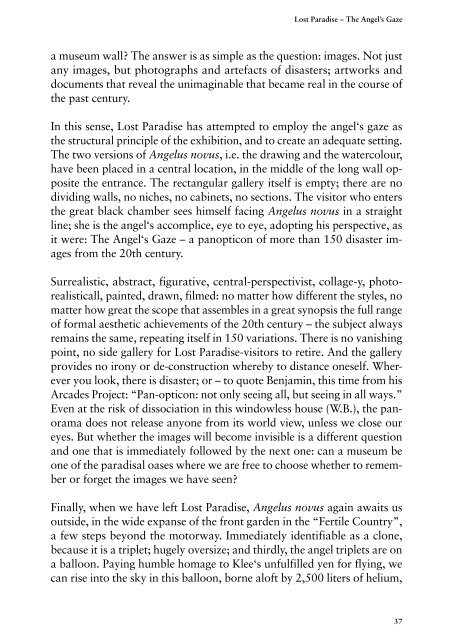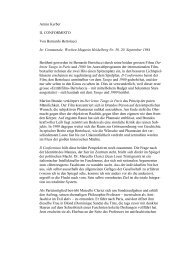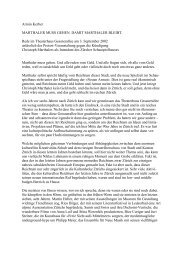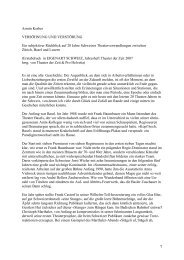You also want an ePaper? Increase the reach of your titles
YUMPU automatically turns print PDFs into web optimized ePapers that Google loves.
<strong>Lost</strong> <strong>Paradise</strong> – The Angel’s Gaze<br />
a museum wall? The answer is as simple as the question: images. Not just<br />
any images, but photographs and artefacts of disasters; artworks and<br />
documents that reveal the unimaginable that became real in the course of<br />
the past century.<br />
In this sense, <strong>Lost</strong> <strong>Paradise</strong> has attempted to employ the angel‘s gaze as<br />
the structural principle of the exhibition, and to create an adequate setting.<br />
The two versions of Angelus novus, i.e. the drawing and the watercolour,<br />
have been placed in a central location, in the middle of the long wall opposite<br />
the entrance. The rectangular gallery itself is empty; there are no<br />
dividing walls, no niches, no cabinets, no sections. The visitor who enters<br />
the great black chamber sees himself facing Angelus novus in a straight<br />
line; she is the angel‘s accomplice, eye to eye, adopting his perspective, as<br />
it were: The Angel‘s Gaze – a panopticon of more than 150 disaster images<br />
from the 20th century.<br />
Surrealistic, abstract, figurative, central-perspectivist, collage-y, photorealisticall,<br />
painted, drawn, filmed: no matter how different the styles, no<br />
matter how great the scope that assembles in a great synopsis the full range<br />
of formal aesthetic achievements of the 20th century – the subject always<br />
remains the same, repeating itself in 150 variations. There is no vanishing<br />
point, no side gallery for <strong>Lost</strong> <strong>Paradise</strong>-visitors to retire. And the gallery<br />
provides no irony or de-construction whereby to distance oneself. Wherever<br />
you look, there is disaster; or – to quote Benjamin, this time from his<br />
Arcades Project: “Pan-opticon: not only seeing all, but seeing in all ways.”<br />
Even at the risk of dissociation in this windowless house (W.B.), the panorama<br />
does not release anyone from its world view, unless we close our<br />
eyes. But whether the images will become invisible is a different question<br />
and one that is immediately followed by the next one: can a museum be<br />
one of the paradisal oases where we are free to choose whether to remember<br />
or forget the images we have seen?<br />
Finally, when we have left <strong>Lost</strong> <strong>Paradise</strong>, Angelus novus again awaits us<br />
outside, in the wide expanse of the front garden in the “Fertile Country”,<br />
a few steps beyond the motorway. Immediately identifiable as a clone,<br />
because it is a triplet; hugely oversize; and thirdly, the angel triplets are on<br />
a balloon. Paying humble homage to Klee‘s unfulfilled yen for flying, we<br />
can rise into the sky in this balloon, borne aloft by 2,500 liters of helium,<br />
37









